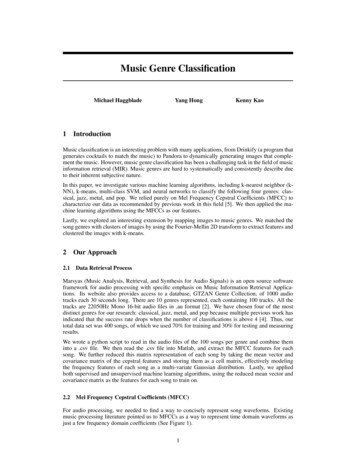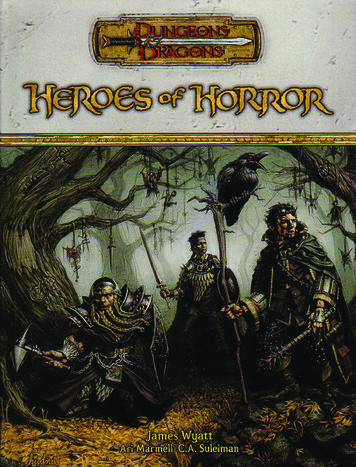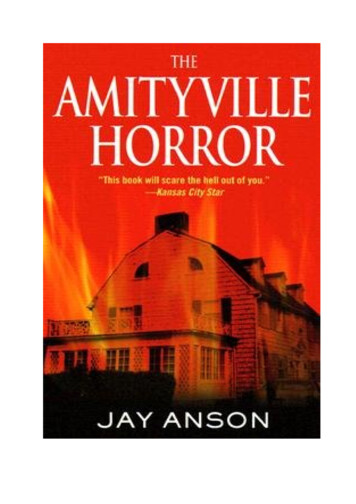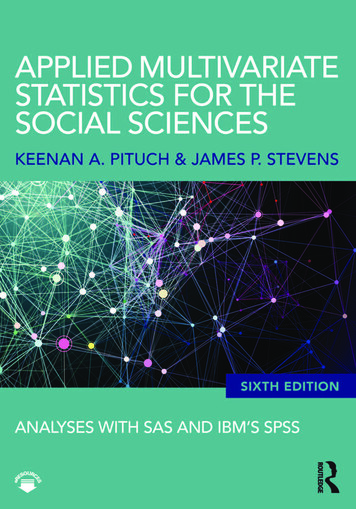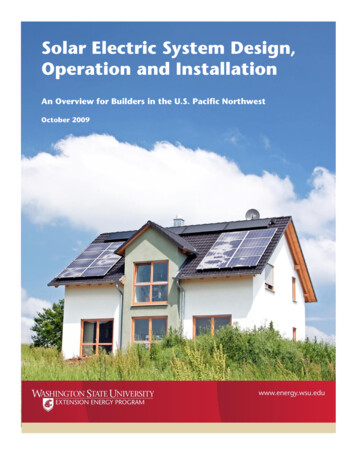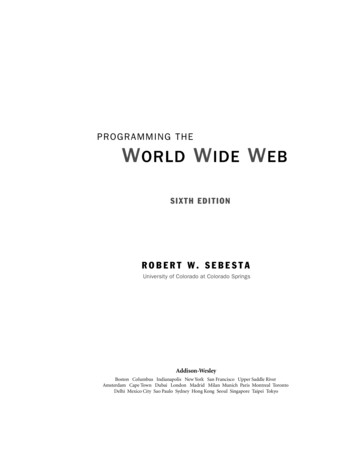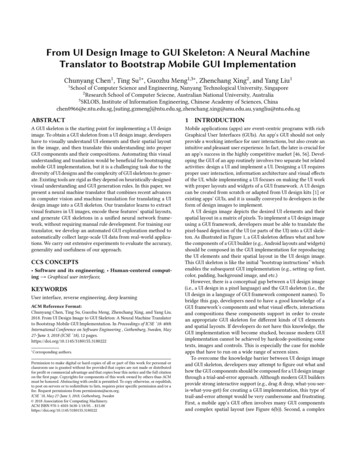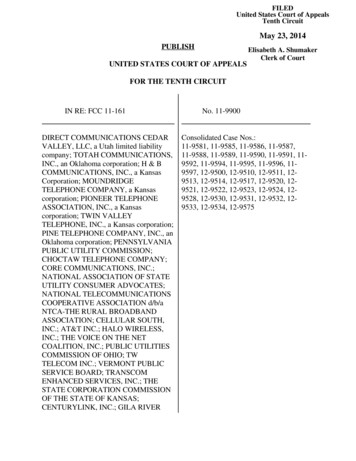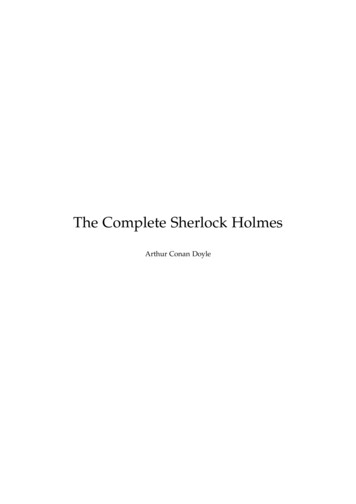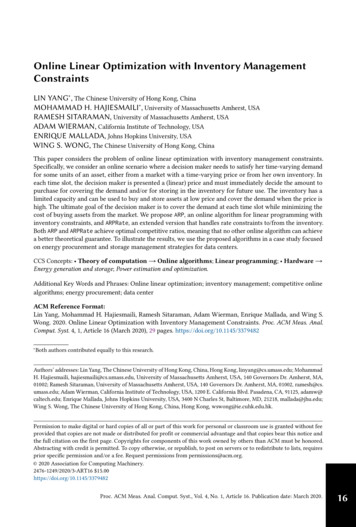
Transcription
American International Journal of Contemporary ResearchVol. 2 No. 4; April 2012The Genre of HorrorMgr. Viktória ProhászkováDepartment of Massmedia CommunicationUniversity of Ss. Cyrill and MethodTrnavaAbstractThe study deals with the genre of horror, outlining it and describing the dominant features and typologicalvariations. It provides a brief overview of the development process in the realm of literature, film and computergames and outlines its appearance in other fields of culture and art. It characterises the readers and viewers ofhorror works and their motives for seeking the genre. The thesis wants to introduce the genre, its representants inSlovak and Czech literature.Key words: genre, subgenre, horror, dread, short story, novel, film, writer, director, game, violence, blood,danger, mystical, supernatural phenomenon, ghost, monster, vampire, zombie, werewolf, murderer.1. IntroductionThe oldest and strongest human emotion is fear. It is embedded in people since time began. It was fear thatinitiated the establishment of faith and religion. It was the fear of unknown and mysterious phenomena, whichpeople could not explain otherwise than via impersonating a high power, which decides their fates. To everyunexplainable phenomenon they attributed a character, human or inhuman, which they associated withsupernatural skills and invincible power. And since the human imagination knows no limits, a wide scale ofarchetypal characters have been created, such as gods, demons, ghosts, spirits, freaks, monsters or villains. Storiesand legends describing their insurmountable power started to spread about them. Despite the fact by thedevelopment of science many so far incomprehensible phenomena have been explained, these archetypes andlegends are still being used in literature and other branches of art. Three genres are based on fear and imagination:science fiction, fantasy and horror, which together form a so-called fantastic triangle. It is why they so oftenoverlap and enrich themselves.2. Horror as a GenreThe definitions of the genre of horror differ. Many authors have tried to create a definition that would be able tocompletely distinguish and separate horror from the similar and close genres science fiction and thriller. However,they always encountered difficulties as the attributes that refer to one genre can be also found in the other one. Tocharacterize horror, as a genre that invokes tension in recipients is not accurate enough, as science fictions,thrillers, detective and crime stories initiate the feeling of suspense as well. The same is to be said about theemotion of fear or the display of blood, which are another attributes of horror production but can be found in theother mentioned genres, too.In his work “An Introduction to Studying Popular Culture” Dominic Strinati created the following definition thatcharacterizes horror “as a genre that represents the need for suppression if the horror shown is interpreted asexpressing uncomfortable and disturbing desires which need to be contained.” 1Horror is a varied genre that is hard to be defined by one single definition. And therefore the most accurate is theone that defines horror through each of its categories and its subgenres. Todorov distinguishes between threeforms of horror as a genre: uncanny, marvelous and fantastic.In the first category – the uncanny, the end of the story contains elements of supernatural, events that seem tobe unreal, impossible or irrational, or events that follow the laws of rational but are incredible, disturbing,unusual, shocking, unexpected or unique.1Strinati, D. (2000) An Introduction to Studying Popular Culture. New York, Londong: Routledge, p. 82132
Centre for Promoting Ideas, USAwww.aijcrnet.comThe viewer/reader has an opportunity to explain them in their own way. Yet the laws of reality remain untouched.Examples of this category are the following films: Taste of Fear (1961), Nightmare (1964), Psycho (1960), orfilms that overlap with the genre of science fiction. Extraterrestrials can be inhuman but not unnatural; theyrepresent the boundaries of human knowledge.In the second category – the marvelous horror, seemingly irrational and incomprehensible phenomena can beexplained only by accepting the second layer of reality – the supernatural while the story lasts. To explain theincomprehensible phenomena of the story we must accept “the new laws of nature”. Films of vampires,werewolves, living dead, demons etc represent this category.The third category – the fantastic horror does not allow us clear explanations of the irrational; it offers usseveral alternatives. The viewer/reader can decide whether they will explain the phenomenon as the existence ofthe paranormal or as a hallucination of the main protagonist. The fantastic horror raises doubts and hesitationbetween the natural and supernatural alternative, which the recipient may (or may not) share with the character.Examples are film such as Shining (1980), Cat People (1942) The Innocents (1920) or I Walked With a Zombie(1943). 23. Subgenres of horrorRural horror, also known as redneck horror, is not related to specific locations only (such as villages or country).It is the horror that is situated in places far from civilization, which also includes a local legend, myth orsuperstition. These are horrors such as Hills Have Eyes (1977, remake 2006, sequel 2007), The Evil Dead (1981),Cabin Fever (2002), Deliverance (1972) or Wrong turn (2003).Cosmic horror is mostly characterized by the work of Howard Phillips‟ Lovecraft. In his books he wrote of acivilization coming from outer space, which conquered the Earth before humankind. Cosmic horror implieselements of science fiction and depicts emotions when a person finds out something he would rather not knowabout. Including Lovecraft‟s works we can also mention the works of Clive Barker, Peter F. Hamilton or TheKing in Yellow by Robert W. Chambers.Apocalyptic horror deals with the end of the world caused by various factors. Therefore it is also called the endof-the-world horror and it is represented by works such as The Stand of The Cell, by Stephen King or the works ofRobert McCammon.Crime horror compounds the elements of crime/detective story and horror. It is based on a criminal plot andescalating tension with an addition of horror elements. This category includes films as Resurrection (1999) Se7en(1995) or the Italian Tenebre (1982).Erotic horror combines the sensual or sexual imagery with horror overtones or elements of the plot. The mostfamous archetypes of the erotic horror are the vampires. Authors such as Wrath James White, Lucy Taylor, CliveBarker, Anne Rice, Michael Garrett, Amy Wrench or Jeff Gelb represent this subgenre.Occult horror focuses on exorcism, the arrival of the antichrist, cults, mysticism, curses and a wide scale of socalled occult sciences. Horrors such as The Exorcist (1973 and the related sequels and prequels), Constantine(2005), The Amityville Horror (2005), The Omen (1976, remake 2006) or Final Destination (2000) are only a fewexamples representing this subgenre.Psychological horror is based on the fear of the main protagonist, on his feelings of guilt, on his faith andunstable emotional state of mind. Further on it develops the plot, the tension and horror as seen in films such asThe Sixth Sense (1999), The Blair Witch Project (1999), American Psycho (2000), Harris‟s cannibal series aboutHannibal Lecter – Red Dragon (2002), Silence of the Lambs (1991), Hannibal (2001) and Hannibal Rising(2007); The Ring (2002, which is the American remake of the original Japanese horror Ringu from 1998) or thenovel of Stephen King called Gerald’s Game.2Todorov, T. (1973) The Fantastic: A Structural Approach to a Literary Concept. IN: Strinati, Dominic. (2000). AnIntroduction to Popular Culture. New York, Londong: Routledge, p.83133
American International Journal of Contemporary ResearchVol. 2 No. 4; April 2012The aim of the surreal horror is not only to tell a terrifying story, but to disturb the recipient as well. Besides theclassical elements of horror this subgenre also contains elements of surrealism: dreaminess, grotesqueness,bizarreness and the fantastic. Good examples are the works of David Lynch or David Cronenberg, Jacob’s Ladder(1990) or Angel Heart (1987).The visceral horror is the most shocking and disturbing of all the subgenres of horror. It is full of blood, gore andbrutality. It depicts the most disgusting and most perverse forms of murder, butchering and mutilation of humanbody. Films such as The Texas Chainsaw Massacre (1974, its sequel, remake and prequel), Saw (2004 and thefollowing sequels), Hostel (2005 and the following sequels), or the works of Jack Ketchum are the most famousrepresentatives of this subgenre. 34. Literature of HorrorThe beginnings of the genre of literature of horror can be derived from the formation of the tradition of gothicliterature, which rose in the 18th century. However, the very beginning of the horror is connected with the worksof English authors, who followed and developed the gothic tradition. They created characters that becamearchetypes for the genre of horror (monster, vampire etc.).Based on the historic tradition and the frequent occurrence of supernatural elements, the genre of horror isconsidered as one “apex of the popular fantasy triangle” together with fantasy and science fiction. It is so despitethe fact that fantastic horror is only one of the two flows of this genre that exist together with the so-calledrealistic horror.Unlike science fiction and fantasy, the definitions of the genre of horror do not stand on the structure of variousworks; they rather focus on the esthetic aspect and emotions, which are evoked in the readers (fear, horror,anxiety etc.) Based on this, horror is defined as “a genre of popular literature focused on evoking emotions ofdread, fear and tension.”4 (Mocná - Peterka)One of the attributes of horror are some typical archetypal characters: vampire, werewolf, zombie, monster, madscientist, demon, ghost, eternal wanderer, serial killer, psychopath, bad child, possessed person, and antichrist.The genre is characterized by dynamism, and therefore it is necessary to note that these are only just a few of thearchetypes, because they keep evolving along with the genre and new archetypal characters are createdperpetually.Another of the genre‟s dominants is the environment in which the story is revolving. First, these were places outof the modern world, such as cemetery, abandoned castle, gloomy forest, castle ruins, old house etc. Most of all,these are places intensively charged with mystery that have “their own lives”. This is also true for the modernenvironment that cuts its way into the modern horror.From the aspect of range we may differentiate between two forms: short story and novel. These two are standingagainst each other as opposites and which alternate in the various historical cycles. The tradition of horror, unlikethe gothic tradition, stems from the form of the short story that elaborates the horror motive in a shorter time,focuses on a smaller amount of characters and this way enables the reader to have a more detailed and morepersonal contact. On the contrary, a novel reflects a story of a longer time span and mostly focused on largercommunities. With its range, it forces the recipient to interrupt the interpretation, which may be of harm in suchan emotionally oriented genre. Despite that, the horror of our days (since the 70s of the 20 th century) is dominatedby the form of a novel.5. Development of the literature of horrorAs mentioned previously, the genre of horror developed from the gothic literature in the 18 th century that reachedits first peak around 1790 and became a dominant genre of its time. Environments with mysterious atmosphereand massive castles were the first setting for authors like Ann Radcliffe, Charles Brockden Brown or MatthewLewis, whose works represented the transformation from the gothic novels to horror. Violence and brutality soopenly described in the contemporary works of horror were only outlined by a few drops of blood on the floor ora piece of cloth torn on the thorns of the bushes.34Mocna, Dagmar, Peterka, Josef a kol. (2004) Encyklopedie literárnych žánrů. Praha : Paseka, s. 253.134
Centre for Promoting Ideas, USAwww.aijcrnet.comThe consecutive genesis of horror as an independent genre began in the early 19 th century. Even though at thebeginning there still were works affected by the gothic fiction, its effect constantly weakened and the horror tookover.The Irish Charles Robert Maturin and English with Italian John William Polidori made a big contribution tothe development of horror. Polidori‟s The Vampyre: A Tale and Maturin‟s novel Melmoth the Wanderer (1920)brought new dimensions of fear. Along with them Marry Shelley wrote her novel Frankenstein; or, the ModernPrometeus (1817), which became a milestone of the classic horror and an inspiration to many filmmakers. Otherfamous authors of this era were Frederick Marryat who contributed with a novel The Phantom Ship (1839) an ashort story The Werewolf; Herbert George “H. G.” Wells, who combined the genre of horror with sciencefiction in his short stories and novels such as The Invisible Man (1897), The Island of Dr. Moreu (1896) or TheWar of the Worlds (1898); and Robert Louis Stephenson with his The Strange Case of Dr. Jekyll and Mr. Hyde(1886).In the late 19th century there were other authors and their works, which excelled in this field. These wereRudyard Kipling with The Mark of the Beast (1891), Bram Stoker with Dracula (1897), Algernon Blackwoodwith The House on the Borderland (1908), Arthur Machen with The Great God Pan (1894), Lord Dunsanywith The Laughter of the Gods (1922), Montague Rhodes James with Count Magnus (1904) and JosephSheridan Le Fanu with In a Glass Darkly (1872).However, the genre of horror is not limited to England only. I
(2005), The Amityville Horror (2005), The Omen (1976, remake 2006) or Final Destination (2000) are only a few examples representing this subgenre. Psychological horror is based on the fear of the main protagonist, on his feelings of guilt, on his faith and unstable emotional state of mind. Further on it develops the plot, the tension and horror as seen in films such as The Sixth Sense (1999 .
